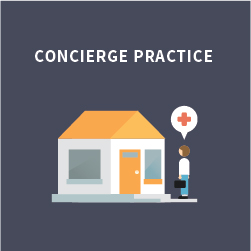Is Concierge Practice Right for You?

In concierge practices, patients pay for enhanced medical access and service. Although they may have been around since the mid-1990s, they have gained significant traction in the past decade. This type of practice charges a retainer from $2,000-20,000 plus per year for the benefit of immediate physician accessibility, more personalized care, telephone visits, executive-type physicals, and sometimes even house-calls.
According to Concierge Medicine Today (CMT), over 80% of concierge practices function as a hybrid type of model, charging a retainer and billing insurance for covered services. ![]()
This retainer-based system allows these practices to reduce their patient panel to less than 500 patients compared to conventional practices, in which over 63% reported a patient panel of more than 1,000 in Kareo’s 2015 Practice Models Perspectives survey.
Concierge and direct-pay practices have many similarities resulting from the fact that the patients seen in these practices take a more active financial role in their healthcare. These practices also share common ground in their price transparency, physician access, and personalized level of service.
Reasons to Consider Switching to a Concierge Practice
- Get more time to spend with patients: According to CMT, concierge physicians see an average of 6-8 patients per day compared to conventional physicians, averaging 20-24. Additionally, Kareo’s 2015 survey showed that 72% of these providers were able to spend 30-60 minutes with each patients compared to the 15-30 minutes spent by their counterparts.
- Reduce reliance on insurance: Separating from the insurer payer system was cited by 46% of doctors who switched their practice to a concierge or direct-pay practice as the reason behind the change. Moving into a retainer-based system, even while billing insurance for covered services, drastically decreases your practice’s reliance on 3rd party claims payments for its financial viability.
- Focus on preventative care: Switching to a concierge practice also allows the physician to focus on lifestyle and preventative care plans for their patients. The retainer charged in these practices can be used to cover these proactive services that insurance typically excludes and allows providers to concentrate on wellness.
Pros and Cons of the Concierge Model
As with every practice model, concierge medicine comes with its advantages and disadvantages. Some of the most obvious advantages of moving to concierge practice include the reasons discussed for switching in the first place, such as:
- Being able to spend more time with each patient to really talk to them and use your skills to their fullest extent
- Relying less on 3rd party payers
Other benefits include:
- Increased job satisfaction
- Decreased time on administrative duties (on average 5 hours less per week according to Kareo’s 2015 survey)
- Fewer staff members required due to less dependence on insurance
- Lower overhead expenses
The negatives of choosing a concierge model include:
- Increased financial impact when patients choose to leave the practice due to the smaller patient pool
- Inability to rely on insurance contract to bring in new patients
- Effective and regular marketing essential to the recruitment of new patients
Legal and Regulatory Issues
Before making the switch to this model, there are potential legal and regulatory issues that must be examined. The first is whether or not the practice will trigger insurance law. These laws vary by state. For example, New York is fairly restrictive and offering unlimited patient visits, even for a high retainer, could classify your practice as an insurance business.
Other states have laws in place that could result in a concierge practice being viewed as discriminating based on the retainer fee required to become a patient. Additionally, practices that accept insurance could violate the hold-harmless clause included in many HMO provider contracts. It is always beneficial to get the advice of an attorney to help you navigate these legal pitfalls.
Federal Medicare laws must also be taken into consideration if the practice will accept Medicare patients since these laws prohibit charging Medicare recipients more than the allowable amount for participating physicians. Concierge practices must also be watchful about including services in their retainer fee that are covered by Medicare as this is considered double-billing and comes with steep penalties.
Many concierge physicians choose to opt-out of Medicare due to these concerns. If you choose to opt-out, make sure to follow the process precisely since violating any of Medicare’s opt-out rules can result in the loss of rights to enter into any private contract and receive any Medicare reimbursement for up to 2 years as well as liability under the False Claims Act.
Making the Decision
If concierge practice is the right choice for you, you may just get the best of both worlds, a retainer-based system that allows you to focus on preventative care and time with your patients as well as insurance billing that supplements your income. Evaluate the pros and cons carefully and seek legal advice to ensure you start off on the right foot and avoid a financial dip during your transition.




















